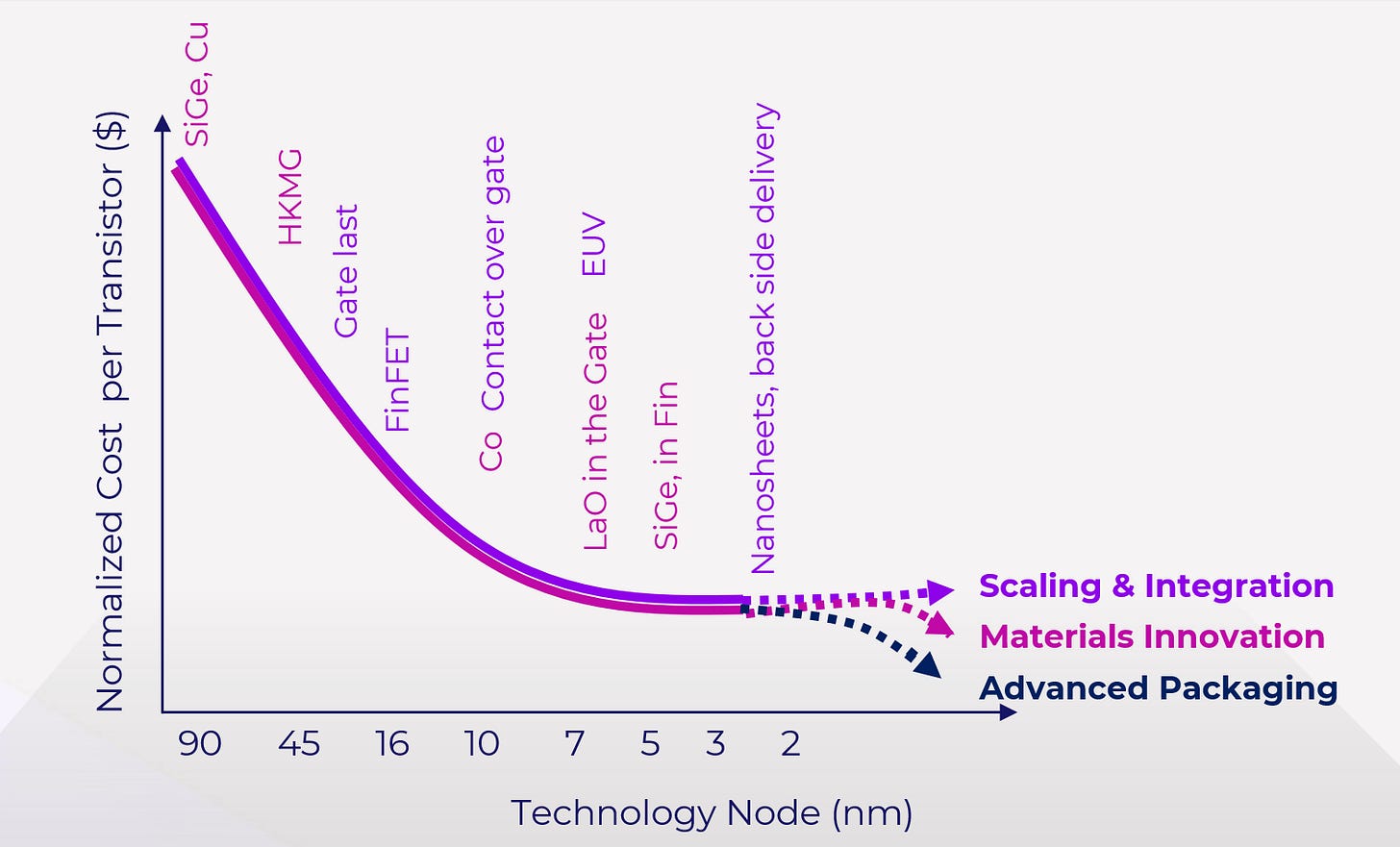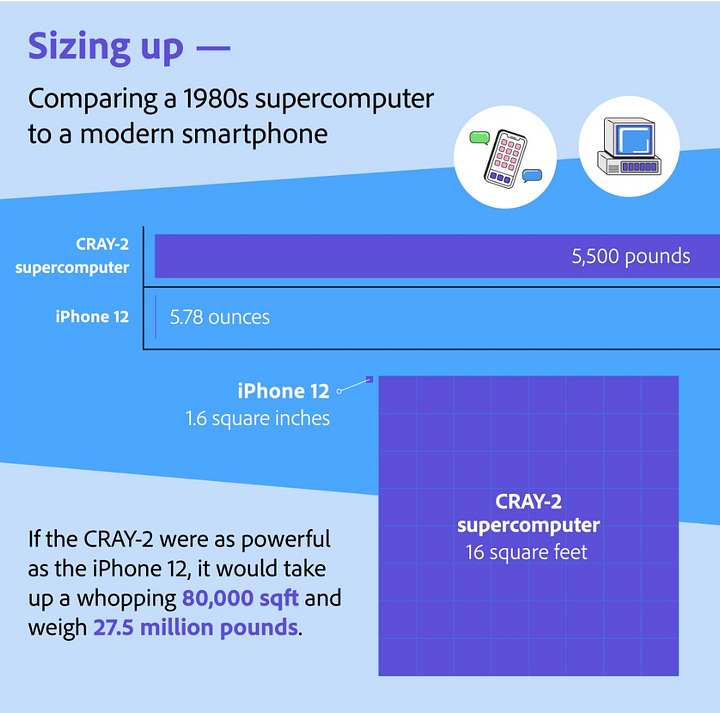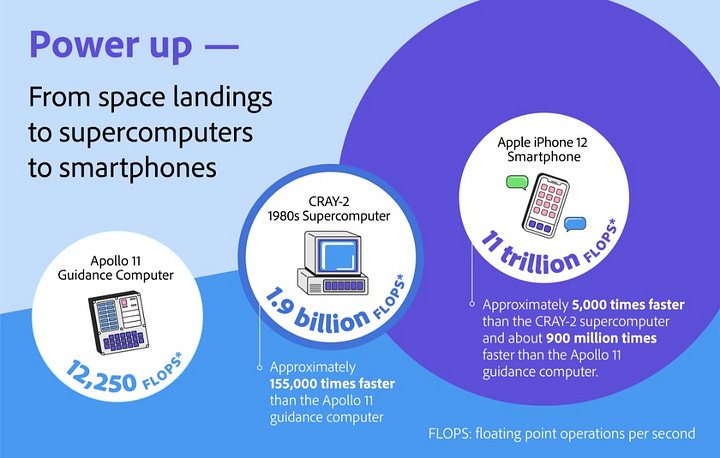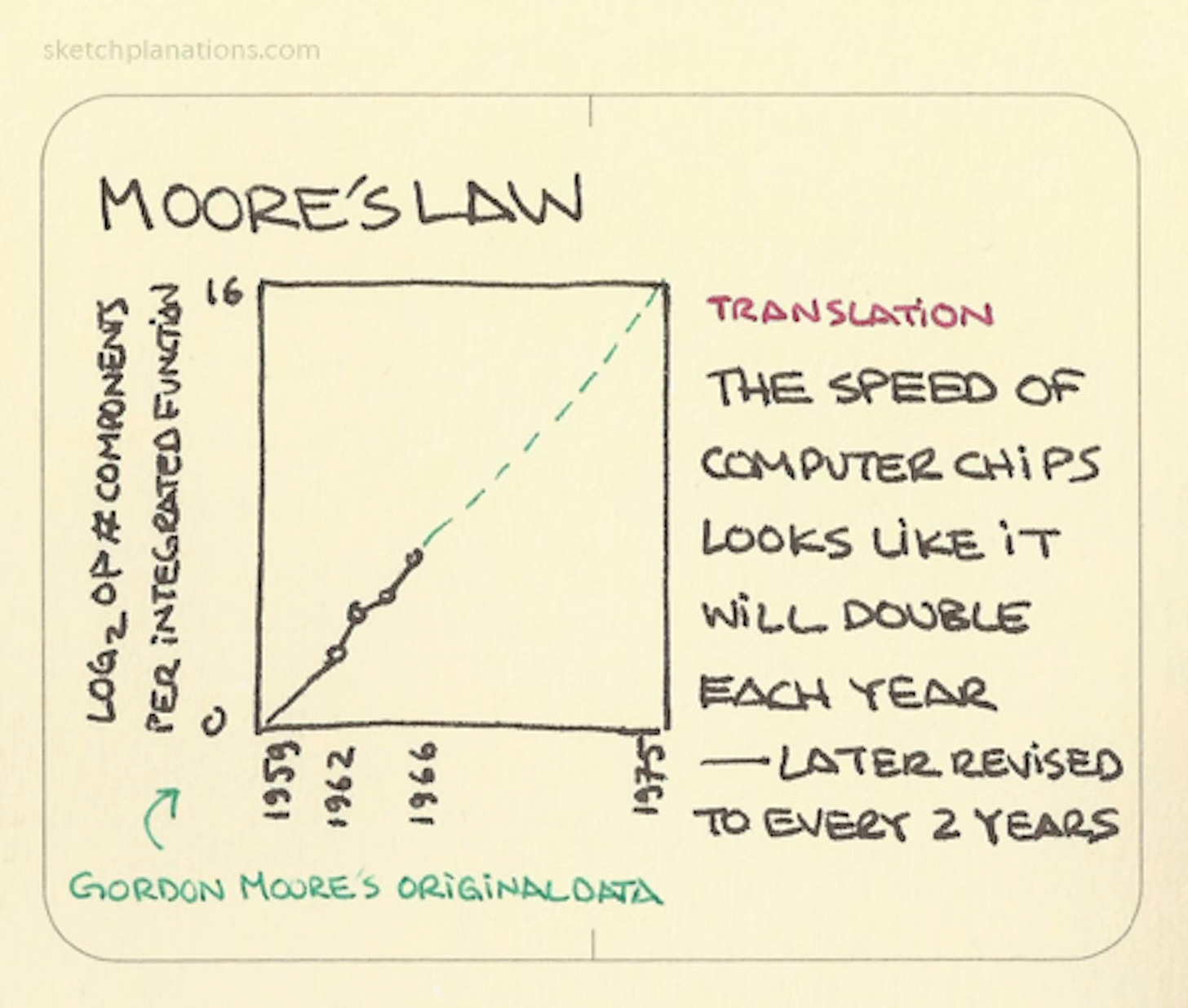This post was sponsored by Nova Ltd. Nova Ltd. is a leading innovator and key provider of dimensional, materials, and chemical metrology solutions for advanced process control used in semiconductor manufacturing. They are a publically traded firm on the Nasdaq. - NVMI 0.00%↑
It’s [Moore’s Law] not dead. It’s not slowing down. It’s not even sick.” (1)
Philip Wong, VP of Research, TSMC
Today we are predicting that we will maintain or even go faster than Moore's Law for the next decade. (2,3,4,5,6)
Intel Chief Executive Pat Gelsinger
Moore's Law isn't possible anymore. (7,17)
Jensen Huang, CEO Nvidia
INTRODUCTION
The semiconductor industry and those who follow it are likely to be familiar with Moore’s Law (Sidebar 1), which describes semiconductor technology improvements in terms of a clocklike cadence of doublings in the number of transistors in an integrated circuit over time.
In existence since 1965 when it was formulated by Gordon E. Moore, a founding father of the semiconductor industry, Moore’s Law had become over the years a cornerstone of industry alignment and progress. Although there were skeptics who would from time to time predict the end of Moore’s Law, these auguries never came to pass. By the turn of the 21st century Moore’s Law had become something of an industry legend.
THE IMPORTANCE OF THE SEMICONDUCTOR INDUSTRY
Superlatives cannot adequately describe the profound effects of the semiconductor industry upon human progress.
The minuscule transistorized computer chips made from semiconductors have become the lifeblood of our 21st-century information society, just as oil was to the industrial world of the 20th century. Without the ubiquitous electronic infrastructure powered by computer chips today, virtually nothing would run. Chip manufacturing may be the most complex, process-controlled industry the world has ever seen. (8)
THE VALUE OF MOORE’S LAW
Moore’s Law accurately charted the pathway in size reduction and thus in performance for those transistors. That information could be translated by business professionals into computer chip production volumes, revenues, and profits. Based on this knowledge, semiconductor companies could more easily raise money on the capital markets to build manufacturing plants, and managers could hire the needed human resources and plan long-term capital investments with lower risk. Investors, producers, system manufacturers, and consumers alike all benefited from the Swiss watch-like regularity of the computer chip product cycles. Unlike no other business in the world, the semiconductor industry had an accurate, proven roadmap for its future…orchestrated to the rhythm of Moore’s Law.
MOORE’S LAW FALTERS - TWICE
But then, after four decades of brilliant success, Moore’s Law faltered, the skeptics arrived in force, and all hell broke loose.
It started with a slowing in Dennard Scaling, the powerful technological underpinning of Moore’s Law, around 2005, thus marking the end the first era of Moore’s Law (Chart 1, Stage I). The semiconductor industry stumbled but quickly recovered with a technology fix that stabilized Moore’s Law for another fifteen years, to about 2020 (Chart 1, Stage II). Then another stumble and another fix was required to keep Moore’s Law on track, arriving at where we are today in 2022 in the very early years of a new Moore’s Law era (Chart 1, Stage III). Although those two stumbles due to technological uncertainty were quickly and effectively settled they still had a profound effect on the semiconductor industry.
THE RESULT: DIVERGENT PROPHECIES, INDUSTRY CONFUSION, AND MOORE’S LAW REPLACEMENTS
And so today, as a result of two apparent failures, the debate over the direction of Moore’s Law continues with increasing urgency, confounding industry veterans and observers alike with recent predictions such as those from Wong, Gelsinger, and Huang. And, as if these seemingly divergent prophecies from industry leaders wasn’t confusing enough, a number of replacements have been proposed for Moore’s Law, as the semiconductor industry equilibrates and searches for a single, effective, overarching, guiding principle.
A few proposed replacements to Moore’s Law include:
• Performance per Watt (9)
• Koomey’s Law (10)
• Huang’s Law (11)
• Energy Efficient Compute (12)
AN EXPLANATION
How to pull these threads together…noting as we did above that one industry expert confusingly claims Moore’s Law will continue, another declares it will accelerate, and yet a third expert insists that Moore’s Law has ended and will be replaced…with at least five viable replacement alternatives proposed.
To start, let’s look at the history and timeline of Moore’s Law.

Three Stages of Moore’s Law
From this history and timeline of Moore’s Law three separate stages are evident (Table 1).
• Stage I, when transistor density is governed by Dennard Scaling, extends from formulation in 1965 to roughly 2005 (“Moore’s Bend”).
• Stage II results as semiconductor dies are expanded in size horizontally (“bigger chips”), usually by increasing core counts (a core is a small CPU or processor built into larger CPU). Stage II extends from around 2005 to 2020 when die sizes reach a practical limit.
• Stage III begins when semiconductor dies are first scaled vertically, and then extends later with new steps to keep Moore’s Law alive: complex 3D structures, and more materials, architectures, connectivity options, and packaging advances (chiplets, etc.). The impact will be astonishing: all industry will have to change from design through manufacturing to process control and testing to realize the changes in Stage III.

Explaining the Divergent Opinions
To explain the different viewpoints on Moore’s Law, we must first realize that it can be viewed from conservative, moderate, or optimistic perspectives. For a conservative purist, for example, “traditional” Moore’s Law may have ended after Stage I concluded around 2005, when Dennard scaling slowed. After that time the economics of continued device scaling and integration became unattractive (Figure 2).

An optimist looking at Figure 2 might conclude the opposite: that Moore’s Law still continues to govern device improvements and could even accelerate for some period of time based on the promise of Stage III technologies.
Moderates who believe Moore’s Law will continue without significant changes fall between these two extreme viewpoints. To a moderate, Moore’s Law could continue at its traditional pace, without slowing or accelerating, into the indefinite future.
What to conclude? Depending upon whether one is an optimist, a pessimist, or a moderate, one’s view of Moore’s Law could be quite different.
A CENTURY OF MOORE’S LAW?
Today many in the semiconductor industry continue to embrace Moore’s Law, although divergent viewpoints are becoming increasingly prominent. But is that bad? A fragmented industry situation could actually be beneficial. A variety of viewpoints, each contending for mindshare, might open the industry to more attention, investment and growth. The inevitable conclusion is that investors, suppliers, customers, and end users should stay closely attuned to semiconductor industry developments or face the risk of falling behind the advanced technology curve. This sentiment was brought home in stunning fashion at the recent IEDM 2022 industry meeting, where a semiconductor industry leader confidently predicted a trillion transistor computer chip by 2030, a paen to Gordon Moore’s brilliant 1965 insight. (22)
Could Moore’s Law last a century? If so, then it is a little over middle age today. Perhaps the promising future of Stage III technologies will carry Moore’s Law forward over the next forty years…and more. (21) Only the future can tell how long Moore’s Law will last.
SIDEBARS
Sidebar 1: Moore’s Law
Moore’s Law is not a law but rather a projection of a historical trend. Moore’s Law forecasts that the number of transistors in a computer chip will double about every two years due to advances in semiconductor technology. Gordon Moore’s original data for the determination of Moore’s Law is shown below.
Sidebar 2: Comparing a 1980s Supercomputer to a Modern Smartphone (23)
The 1980s supercomputers were light-years ahead of the one that helped put Neil Armstrong on the moon more than half a century ago. By 1985, the supercomputer CRAY-2 had become the fastest and most powerful machine ever built. It set the world record with a peak performance of 1.9 gigaflops, or 1.9 billion floating point operations per second (FLOPS), vastly exceeding the 12,250 FLOPS peak performance of the Apollo 11 Guidance Computer just 16 years earlier. But…compare that to today’s smartphones, which are about 5,000 times faster than the CRAY-2 and have democratized technology for everyone.


Sidebar 3: Dennard Scaling (24)
Proposed by Robert H. Dennard in 1974 while working as an IBM researcher, the semiconductor scaling law named after him states that as transistors get smaller, their power density stays constant in proportion with area, because voltage and current both scale (downward) with length. While Dennard Scaling held, smaller transistors ran faster, used less power, and cost less. But there was a limit to how long this would last. Dennard scaling began to break down around 2005.
References
1. TSMC Thinks It Can Uphold Moore’s Law for Decades
https://www.nextplatform.com/2019/09/13/tsmc-thinks-it-can-uphold-moores-law-for-decades/amp/
2. Intel will outpace Moore’s Law, CEO Pat Gelsinger says
https://www.cnet.com/tech/computing/intel-will-outpace-moores-law-ceo-pat-gelsinger-says/
3. Intel will outpace Moore’s Law, CEO Pat Gelsinger says https://www.cnet.com/tech/computing/intel-will-outpace-moores-law-ceo-pat-gelsinger-says/ https://www.tomshardware.com/news/intels-pat-gelsinger-on-super-moores-law-making-multi-billion-dollar-bets
https://www.tomshardware.com/news/intel-announces-idm-20-foundry
4. Pat Gelsinger Takes us on a Look Ahead
https://www.techinsights.com/blog/pat-gelsinger-takes-us-trip-down-memory-lane-and-look-ahead
5. "Today we are predicting that we will maintain or even go faster than Moore's law for the next decade.” Intel Chief Executive Pat Gelsinger (XYZ)
https://www.cnet.com/tech/computing/intel-will-outpace-moores-law-ceo-pat-gelsinger-says/
6. Intel's Pat Gelsinger on 'Super Moore's Law,' Making Multi-Billion Dollar Bets
7. Nvidia’s Jensen Huang once again claims Moore’s Law is dead
8. It’s the most process-controlled industry in the world
9. Performance Per Watt Is the New Moore’s Law- ARM
https://www.tomshardware.com/news/arm-performance-per-watt-new-metric
10. Koomey’s Law
11. Huang’s Law- NVIDIA
12. Energy Efficient Compute- TSMC
13. The future of computing beyond Moore’s Law https://royalsocietypublishing.org/doi/10.1098/rsta.2019.0061
14. DOE on collision course with end of Moore’s Law
https://www.nextplatform.com/2019/05/06/doe-on-collision-course-with-end-of-moores-law/
15. What’s Happening in a “Lawless” Industry?
https://semiengineering.com/designing-ics-in-an-increasingly-lawless-industry/
16. No Law- Semiconductor Engineering
https://semiengineering.com/how-to-compare-chips/?cmid=e55c5b75-8f13-4203-a2f1-3b8330fb988a
https://semiengineering.com/designing-ics-in-an-increasingly-lawless-industry/
17. Is Moore’s Law actually dead this time? Nvidia seems to think so.
18. Introduction to GPU
https://enccs.github.io/OpenACC/0.01_gpu-introduction/
19. One Teaspoon of Soil Contains More Living Organisms Than There are People in the World
20. This is how coronavirus compares…
21. The True Nature of Moore’s Law- Driving Innovation for the Next 50 Years https://www.forbes.com/sites/tiriasresearch/2022/10/07/the-true-nature-of-moores-law--driving-innovation-for-the-next-50-years/?sh=6efa687d1aa3
22. Intel Research Fuels Moore’s Law and Paves the Way to a Trillion Transistors by 2030
23. Fast-forward – comparing a 1980s supercomputer to the modern smartphone
24. Dennard’s Law
https://semiengineering.com/knowledge_centers/standards-laws/laws/dennards-law/
Background Articles
Technology Advances
The Transistor of 2047: Expert Predictions
https://spectrum.ieee.org/the-transistor-of-2047-expert-predictions
3D-Stacked CMOS Takes Moore’s Law to New Heights
https://spectrum.ieee.org/3d-cmos
TSMC Approaching 1 nm with 2D materials breakthrough
https://www.edn.com/tsmc-approaching-1-nm-with-2d-materials-breakthrough/
DRAM’s Moore’s Law is Still Going Strong
https://spectrum.ieee.org/micron-dram
Intel Unveils its Plans to Accelerate Moore’s Law at IEDM 2021
Moving from SoCs to Chiplets could help extend Moore’s Law
https://www.eetimes.com/moving-from-socs-to-chiplets-could-help-extend-moores-law/
AMD EPYC Genoa Gaps Intel Xeon in Stunning Fashion
https://www.servethehome.com/amd-epyc-genoa-gaps-intel-xeon-in-stunning-fashion/
The Smallest Chip Ever- IBM Two-Nanometer Chip
https://time.com/collection/best-inventions-2022/6228819/ibm-two-nanometer-chip/
Moore’s Law Ends?
The future of computing beyond Moore’s Law
https://royalsocietypublishing.org/doi/10.1098/rsta.2019.0061
“The classical technological driver that has underpinned Moore’s Law for the past 50 years is failing [3] and is anticipated to flatten by 2025” -John Shalf
The future of computing beyond Moore’s Law https://royalsocietypublishing.org/doi/10.1098/rsta.2019.0061
DOE on collision course with end of Moore’s Law
https://www.nextplatform.com/2019/05/06/doe-on-collision-course-with-end-of-moores-law/
Chip Design Shifts As Fundamental Laws Run Out of Steam
Dennard scaling is gone, Amdahl’s Law is reaching its limit, and Moore’s Law is becoming difficult and expensive to follow.
Moore’s Law is Dead- Long Live the Chiplet!
https://semiwiki.com/chiplet/318859-moores-law-is-dead-long-live-the-chiplet/
Big Changes in Architectures, Transistors, Materials
https://semiengineering.com/big-changes-in-architectures-transistors-materials/
How to Compare Chips
Traditional metrics no longer work in the context of domain-specific designs and rising complexity.
https://semiengineering.com/how-to-compare-chips/?cmid=778f62b4-b135-435c-8d58-34bcf6c15e5d
Designing Chips in a ‘Lawless’ Industry
https://semiengineering.com/designing-ics-in-an-increasingly-lawless-industry/
Moore’s Law is Broken- That’s Why We Built Our Own Cloud
https://www.man.com/single-core-stagnation-and-the-cloud
Is Moore’s Law Still Ticking?
https://www.sitime.com/company/news/blog/moores-law-still-ticking
How Is the Semiconductor Industry Handling Scaling: Is Moore's Law Still Alive?
Other Topics
What is Koomey’s Law and why could it replace Moore’s Law in importance among chip makers?
42 Years of Microprocessor Trend Data
https://www.karlrupp.net/2018/02/42-years-of-microprocessor-trend-data/
Pat Gelsinger Takes us on a Trip Down Memory Lane- and a Look Ahead
The High Price of Smaller Features
https://semiengineering.com/the-high-price-of-smaller-features/
The path to 1nm chips and beyond





